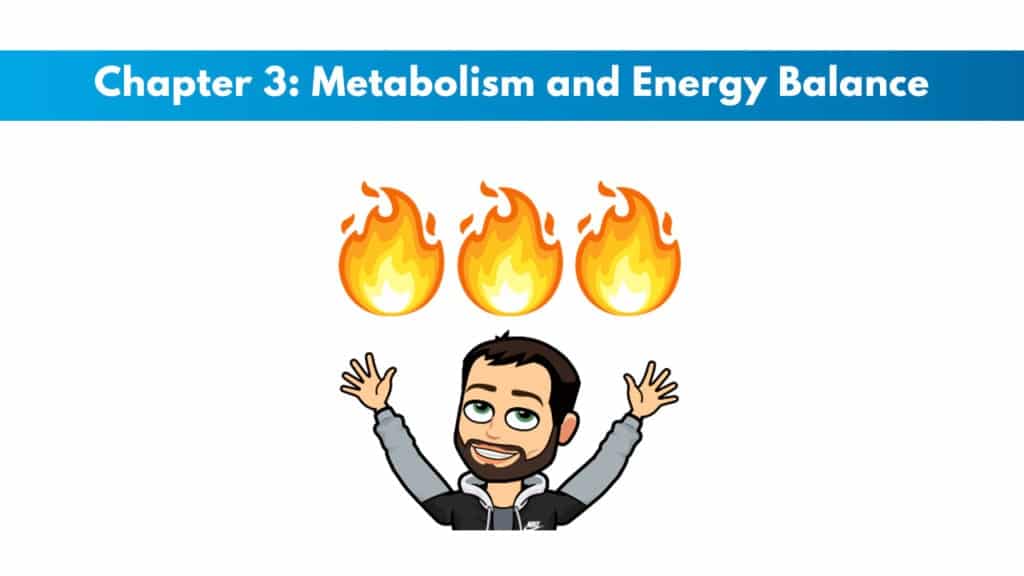
If you have not yet signed up for the ISSA Nutritionist certification, you can get it here for free as part of a special bundle.
Get your copy of the ISSA Nutritionist exam cheat sheet. It helps immensely for studying for the exam.
My PTP students report cutting their ISSA Nutritionist study time and effort in half with Trainer Academy.
Benefit from the Exam Pass Guarantee and Retake Fee Guarantee. Plus, take advantage of my current discount code PTPJULY for 50% off the MVP Program (Ends July 17th, 2025).
Try it out for free here to see if it’s right for you, or read my detailed review for further insights.
Chapter Goals:
- Be able to explain the human energy balance and the components that go into our intake and expenditure.
- Know the metabolism of humans at a cellular level.
- Be able to differentiate between both aerobic and anaerobic energy systems within the body.
- Find the body’s energy currency and know how it works within our energy systems.
Introduction
Metabolism is how the human body converts the consumed foods into energy sources for us to power physiological processes.
The body’s energy requirements for bodily functions and physical activity are met by the digestion and absorption of nutrients and the presence of oxygen. The balance here between the consumption of nutrients and the energy demand is known as the energy balance.
Nutrition and Energy Balance
Metabolism is a very complicated chemical process that happens within the body’s cells.
When it comes to nutrition, it is important to understand these processes and the balance of energy.
In terms of nutrition, energy is provided by a calorie. We write this technology as a kilocalorie or a kcal. This energy is needed to raise the temperature of 1 gram of water by 1 degree Celsius at a pressure of 1 atmosphere.
The calorie content for the various macronutrients is as follows for every 1 gram:
Cards are around four kcals
Proteins are around four kcals
Fats are around nine kcals
Stored fat from carb sources is around 3.27 kcals
Alcohol is around seven kcals
Energy intake
The total intake of calories in a 24 hour period will be used to measure energy balance.
If someone gains weight over time, they consume more calories than they spend. On the contrary, if someone loses weight over time, they consume fewer calories than they expend.
Excess calories lead to gaining weight, and deficiency in calories leads to losing weight.
Research shows the average American takes in around 3,600 calories within a day, which is an increase of about 24% from the average of 2,880 calories a day in 1961.
Current guidelines for adults from the US department of health and human services have declared that the average adult female needs 1,600 – 2,400 calories daily, and the average adult male needs 2,000 – 3,000 calories daily.
Energy intake should be measured by surveying someone’s food consumption over a 24 hour period. While the average human may consume 3,500 – 3,600 calories per day, the actual self-reported calories per day are more along the lines of 2,639 for men and 1,793 for women.
Energy expenditure
This is measured in many ways, with the classic way being a calorimeter, which measures heat production.
Direct calorimetry uses an insulated chamber to measure the heat added to the ambient environment, while indirect calorimetry measures oxygen consumed and carbon dioxide produced.
Exclusive PTP CPT Offers |
||
|---|---|---|
Most Popular Cert | Best Online NCCA Cert | Best Study Materials |
Gold Standard Cert | A Good Option | Best CPT for you?  |
The energy expenditure results from the cumulation of four main processes in the body: RMR, TEF, physical activity, and physical growth.
Resting Metabolic Rate
This energy is needed to support cardiac function and respiration, repair the internal organs, maintain the body’s temperature, and balance water and ion concentration across the cell membranes.
The RMR is correlated to both body size and gender. Determining this RMR for someone is nearly impossible. We do have some formulas that help to predict it, though:
Females: RMR = 248 x weight (0.4356) – (5.09 x age)
Males: RMR = 293 x weight (0.4330) – (5.92 x age)
Thermic Effect of Food
The TEF accounts for the heat loss resulting from energy consumed when the body digests carbs, fats, and proteins.
We also refer to this as diet-induced thermogenesis, and the thermic effect will vary depending on the macronutrient.
Physical Activity
This is second only to the RMR regarding its effect on daily energy expenditure.
This category includes the body’s movement, and it is directly related to the size of the person’s body and their level of physical conditioning.
The more that someone moves, the more energy they will expend.
Growth
The body is always growing and changing in small ways. We have millions of cells dying every day, and of course, millions are replacing them.
For babies, infants, and other youth, we see their bodies maturing and growing more rapidly, meaning more cells are being created than dying daily.
The energy cost of physical growth varies at different stages of life, but it is an important factor in the total overall expenditure of the body.
The aspect of growth applies especially to pregnant women supporting their own cell growth and the growth of their fetus.
Energy Balance
Creating an energy balance involves more than simple management of weight.
A positive energy balance means that more energy is being consumed than is expended, and this would lead to gaining weight.
A negative energy balance means that more energy is being expended than consumed, leading to losing weight.
The body has a habit of naturally seeking a homeostatic balance of the energy system, which can be quite evident in weight gain patterns. Over time we see that people who gain body weight will often have periods of their weight plateauing, regardless of the presence of positive energy balances.
Cellular Energy Currency
Cellular metabolism can often be referred to as cellular respiration. This is where a series of reactions occur that convert nutrients into the cellular energy currency of ATP or adenosine triphosphate.
Adenosine is made up of adenosine and ribose. And this is then attached to three phosphates, and the two bonds between the three phosphates store and release energy.
The body has all of the raw materials needed to produce ATP.
Converting ATP into Energy
ATP alone does not provide cellular energy. This energy is stored in the bonds between the three phosphates in the ATP molecule, which need to be broken in the presence of water to release the energy.
ATP to adenosine diphosphate plus energy
The first step is for the adenosine triphosphate to break down into a simpler counterpart of adenosine diphosphate.
Exclusive PTP CPT Offers |
||
|---|---|---|
Most Popular Cert | Best Online NCCA Cert | Best Study Materials |
Gold Standard Cert | A Good Option | Best CPT for you?  |
The break requires the enzyme, which is ATPase, which breaks the second and third phosphate to release stored energy.
ATP – ADP Cycle
This process allows the cleaved ADP to be recycled back into functional ATP in the cell. The process of reattaching phosphate, which we call rephosphorylation, will require the enzyme of ATP synthase.
The breakdown of ATP to release the stored energy is known as ATP hydrolysis.
Muscles constantly generate protons during basic cellular metabolism, whether you are at rest or in an activity. The body manages the hydrogen ions easily during rest or light activity by moving them to the mitochondria of the cells, where the energy is harnessed to resynthesize ATP with the use of O2 and water formation.
ADP to Adenosine Monophosphate
In the compound of ADP, two phosphate ions are still left, and their bond will still contain stored energy. We can use this remaining bond to generate needed cellular energy during extreme circumstances.
For an all-out sprint of 10 – 15 seconds, the body will have energy needs that exceed what the ATP-ADP cycle can actually provide.
The Energy Systems
The body has three different energy systems, which can be classified as short-term, intermediate-term, and long-term. The systems will overlap in everything that a human does.
Overview of the Energy Systems
Muscle tissues have enough stored ATP to last only a couple of seconds, and then to quickly make more ATP, muscles turn to phosphocreatine.
This entire phosphocreatine process provides an instant energy source, or up to 30 seconds worth.
This system using phosphocreatine is known as the phosphagen system.
As the muscle tissue continues to use phosphocreatine, glycolysis, where ATP is made from glucose, emerges as the main source of our energy.
This happens around 7 seconds into a run.
In glycolysis, a series of reactions allows the body to break down the glucose molecule into two pyruvate molecules, producing a small amount of ATP for a short amount of time, around 2 minutes.
The phosphagen system and glycolysis are both anaerobic processes, meaning they do not use oxygen in their processes.
When oxygen is added to anaerobic glycolysis, a few complex steps are added to break down the pyruvate unit and generate ATP in the mitochondria.
Aerobic metabolism can now manufacture ATP for longer periods, which introduces the use of fat as a fuel source.
The primary energy sources will be glucose, fatty acids, lactate, and ketones.
Phosphagen System
Every cell in the body has cytoplasm; in muscle cells, we refer to it as sarcoplasm. This serves the purpose of cytoplasm in normal cells.
The sarcoplasm has the actions of the phosphagen system taking place.
Phosphocreatine includes one phosphate molecule connected to one molecule of creatine. Creatine is naturally found in muscle tissue, and keeping average stores of creatine will depend on the overall mass of muscles.
Replenishing phosphocreatine is important since it is used at the onset of activity.
Naturally, this molecule is synthesized in the kidney, pancreas, and liver from the amino acids methionine, glycine, and arginine.
Creatine is stored in muscle tissue, but also it has been found as a major substrate in the brain.
Glucose is the next fastest source of ATP, which will be stored as glycogen in the human body.
Anaerobic Glycolysis
Unlike the phosphagen system, glycolysis occurs in the cytoplasm of almost all human cells, not just the muscle cells like with creatine.
Unlike the phosphagen system, which is an alkalinizing process, glycolysis acidifies the muscle.
Aerobic Metabolism
Aerobic metabolism produces ATP when oxygen is present. The process of aerobic metabolism begins with acetyl coenzyme A after the pyruvate molecule enters the mitochondria. This molecule is required to be formed regardless of what the fuel is going to be.
The second stage here is the electron transport chain, which is also known as oxidative phosphorylation. This forms most of the ATP that is made during aerobic metabolism.
Mitochondria
These cell organelles are essential for generating the chemical energy needed for cellular processes. Some cells in the human body have more mitochondria than others do.
The specialized organelles have a dual membrane. The outer membrane acts as skin, while the inner one is folded like that of the intestines.
The inner matrix of the mitochondria is filled with enzymes, water, and proteins, as well as the unique DNA and ribosomes of the organelle.
Glucose for fuel
Glycolysis splits glucose into a pair of pyruvates in the sarcoplasm of the muscle cell. With sufficient oxygen, pyruvate moves from the sarcoplasm into the mitochondria, where aerobic metabolism starts.
Fatty Acids for fuel
Fat is stored throughout the body in three different locations.
In the midsection, the area between the abdominals and organs, this fat is called visceral fat.
Right beneath the skin is what is known as subcutaneous fat, which is the most widely distributed fat in the body. Inside the muscles, we have intramuscular fat.
Fat is stored in all three of the locations as triglycerides.
Lactate for fuel
Muscle tissue produces lactate in short term contraction, even with sufficient oxygen. Lactate can be used for energy by remaining in the muscle or moving to other areas.
Ketones for fuel
Ketones are an acidic by-product of fatty acid metabolism, produced in the liver when glucose is unavailable.
These ketones are a normal part of human metabolism and are usually well-controlled by insulin and glucagon hormones.
Trouble arises when starvation, severe illnesses, infection, or the presence of chronic diseases like diabetes forces the liver to metabolize large amounts of fatty acids.
Ketones have an effect in extreme circumstances, like:
- A diet that is low in carbs
- A very low-calorie diet
- An extreme physical endurance event
Ketones are a key energy source in the brain in these circumstances.
Acetyl-CoA
Regardless of the fuel source, acetyl-CoA is the central metabolite initiating the aerobic metabolism process within the mitochondria.
The Citric Acid Cycle
The Krebs cycle is also called the citric acid cycle, named for one of its by-products.
The cycle consists of eight consecutive steps in a closed loop, meaning that the process’s final step re-creates the compound used in the first step of the cycle.
The Electron Transport Chain
This is the stage where most of the ATP is produced in aerobic metabolism.
The fuel production from various fuel sources:
Glucose results in around 30 – 32 ATP
Fatty acids result in around 106 ATP
Lactate results in around 30 – 32 ATP
Ketones result in around 22 ATP

 Have a question?
Have a question? 



Tyler Read
PTPioneer Editorial Integrity
All content published on PTPioneer is checked and reviewed extensively by our staff of experienced personal trainers, nutrition coaches, and other Fitness Experts. This is to make sure that the content you are reading is fact-checked for accuracy, contains up-to-date information, and is relevant. We only add trustworthy citations that you can find at the bottom of each article. You can read more about our editorial integrity here.